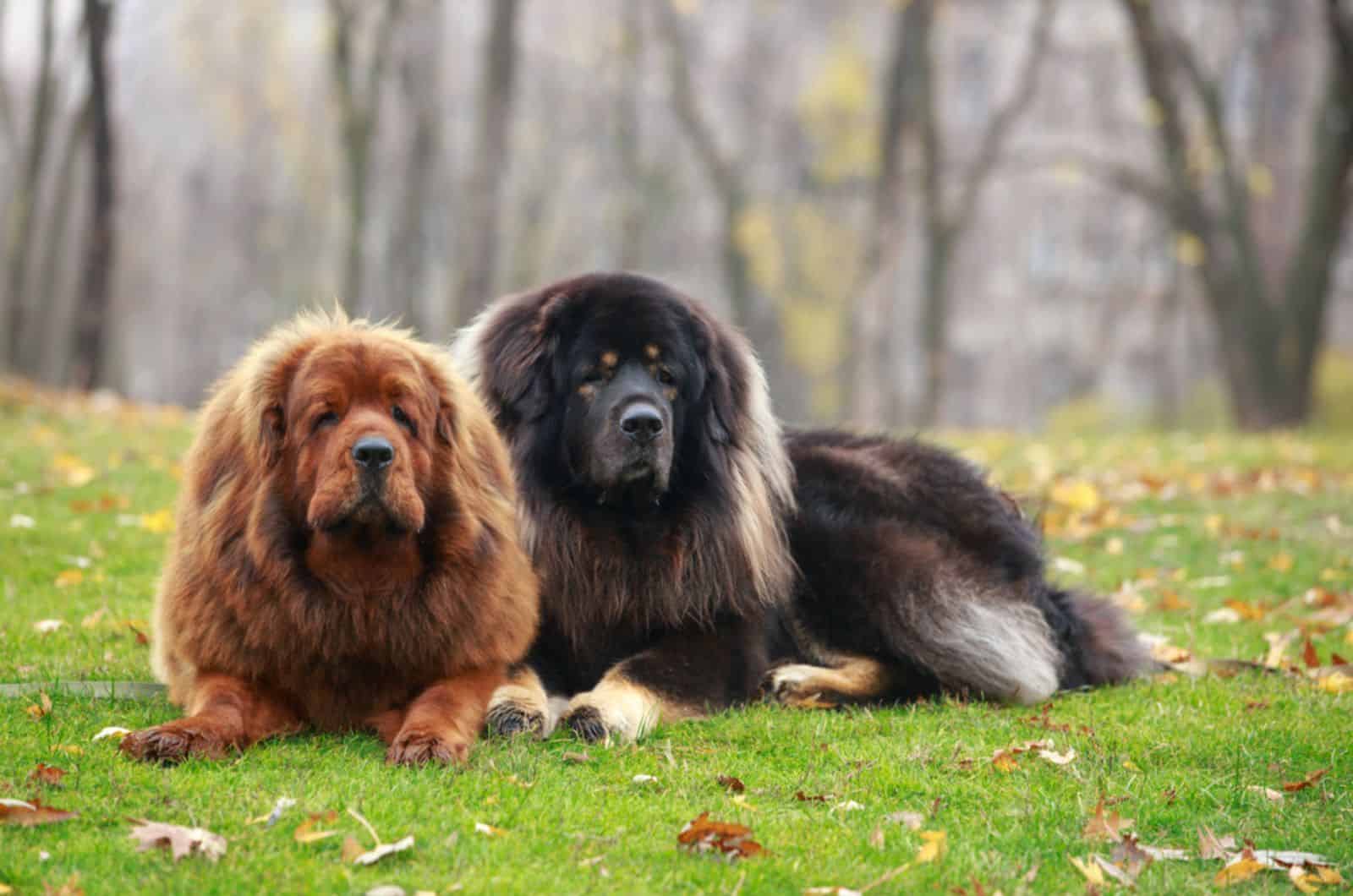No matter the role you assign to your Mastiff, its color will be one of the deciding factors when buying this breed. There is no shortage of Tibetan Mastiff colors, even if you are looking for a show dog.
As with every other dog breed out there, there are breed-standard colors and the rarer colors or patterns produced by pairing dogs with recessive genes. While the controversy surrounding the ethics of breeding such dogs is here to stay, it does not make the dog a wrong choice.
We will also talk about dog genetics, which is essential for understanding how breeders produce these less common, non-standard coat colors. A more in-depth explanation of all things canine genetics can be found toward the end of the article.
Breed-Standard Tibetan Mastiff Colors
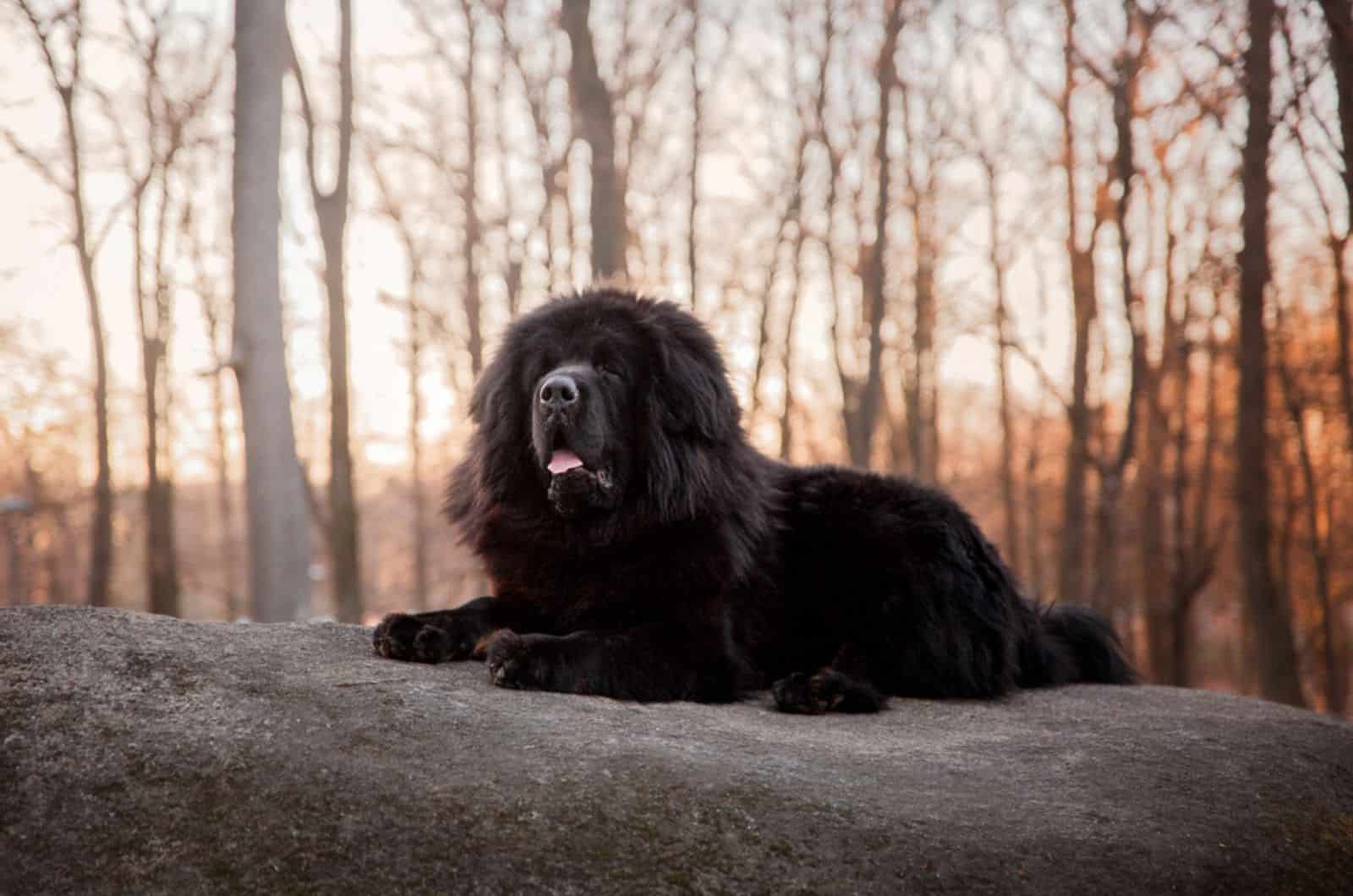
The Do Khyi, meaning “tied dog”, is another name for this Tibet-born large dog with a unique coat quality and several color possibilities. Participating in a conformation event requires your dog to look a certain way, and coat color is one of the most important aspects.
As we go through the list of coat colors recognized by the American Kennel Club, you will see that marking placement does not change, but they can come in a few different shades. White markings are acceptable but will not win you any trophies.
1. Black Tibetan Mastiff
For a fully black Tibetan Mastiff, the K locus will have two dominant genes on it. Though the most common scenario is a Kᴮ/Kᴮ pairing, the black coat can, less commonly, be due to two recessive genes on the A locus.
A solid black Tibetan Mastiff can have white or no markings because it inherits dominant genes from both parents – Kᴮ. No tan or red is possible on a K locus dominant pairing since eumelanin controls black, and phaeomelanin gives the red color.
2. Black And Tan Tibetan Mastiff
The A locus (agouti) controls how much eumelanin and phaeomelanin are used to “paint” the Tibetan Mastiff color. When the puppy’s parents have two recessive genes on the K locus (Kʸ/Kʸ), coloring will depend on the A locus.
A black and tan Tibetan Mastiff puppy will have two Aᵗ alleles (variations of a gene) on the A locus, which will give it tan markings on the head, legs, tail, neck, and sometimes even color the entire undercoat. Another possible combination of alleles for black and tan is Aᵗ/a.
3. Brown Tibetan Mastiff
If a Tibetan Mastiff puppy has two recessive genes b/b on the B locus, its coat will be fully brown. For this to happen, both parents must be brown (have the brown color expressed on their coats).
This is a dilute of the black color that is usually expressed on the B locus with two dominant B alleles. Brown Tibetan Mastiffs are usually fully brown, but white or tan markings are possible.
4. Red Gold Tibetan Mastiff
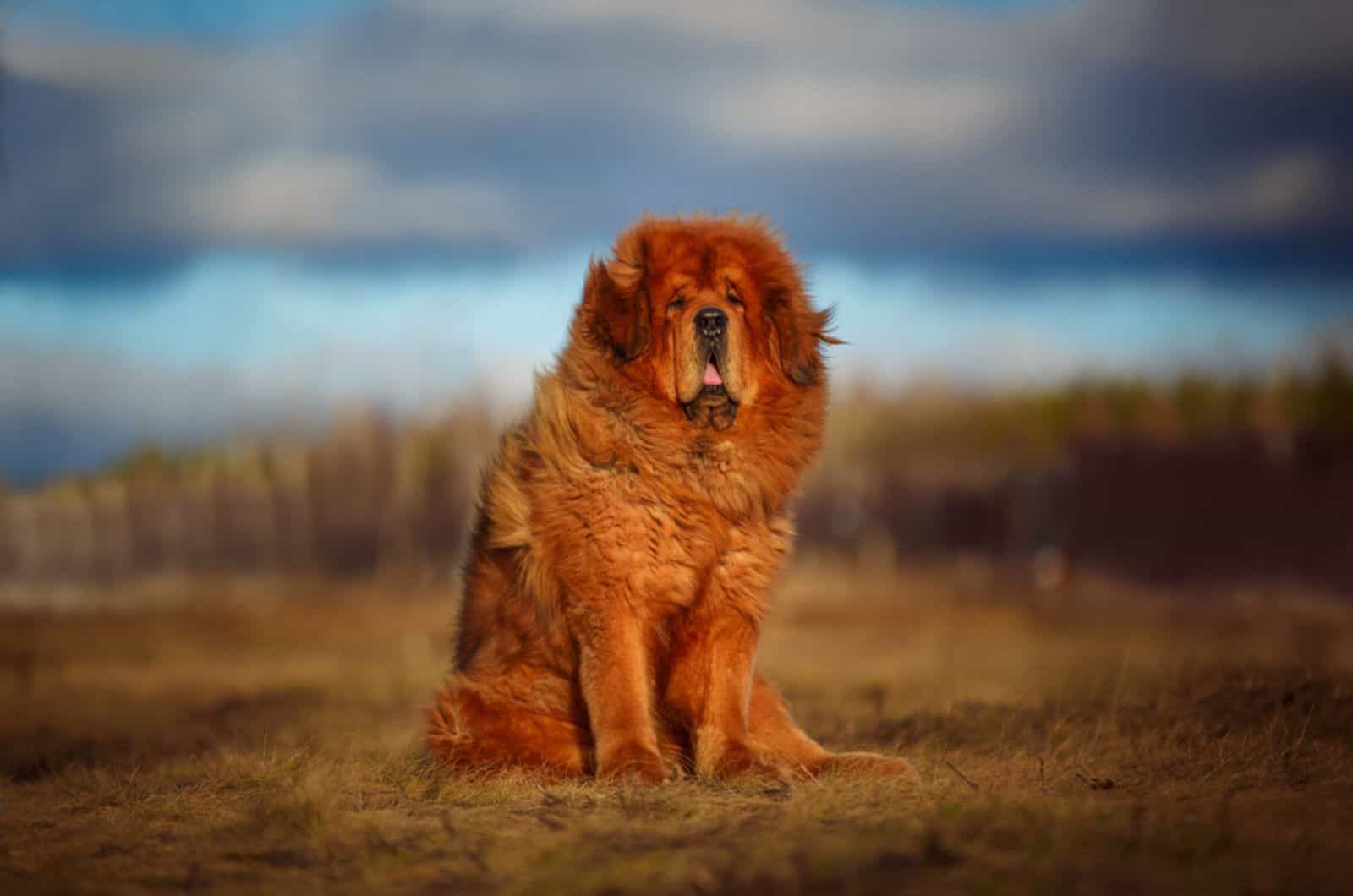
As we already know, eumelanin is the black pigment, whereas phaeomelanin is its red counterpart. Red gold Tibetan Mastiffs must have two recessive genes (e/e) on the E locus.
With those two alleles, the production of eumelanin is inhibited, so only the red pigment colors the dog’s coat. To get the gold part, the D locus (dilute) has to reduce the intensity of the red pigment into a lighter shade, which is gold in this case.
Red Gold Tibetan Mastiffs are a luxury item. In 2014, a Chinese businessman bought a red gold Tibetan Mastiff for almost two million dollars at a luxury pet fair in China. This is the world record for the most expensive dog ever sold by a breeder.
5. Brown And Tan Tibetan Mastiff
Two recessive genes on the B locus and an Aᵗ on the A locus will give a main coat of brown with tan markings. Sometimes it is possible that this combination produces a puppy with very slight differences between the markings and main coat color.
6. Blue Gray Tibetan Mastiff
This one is quite interesting from the genetic point of view. We know that the Tibetan Mastiff breed gets a black color from a pair of dominant genes on the K locus that gives it that deep, full black.
However, to get a blue-gray Tibetan Mastiff, the dominant genes on the K locus have to be diluted by the recessive gene pair on the D locus (d/d). Since these alleles produce both gray and blue colors, the A locus will give it the correct distribution of blue-gray main coat and white markings.
7. Red Gold Sable Tibetan Mastiff
An e/e combination on the E locus will provide the hair with phaeomelanin to create red, and by interacting with the D locus and a pair of recessive d/d genes, some areas will become gold.
The A locus controls how much of each pigment (black and red) is used when coat color is created, so the Ay dominant gene, in combination with any other allele from this locus, will produce the sable or fawn pattern.
Another type of recessive gene that produces sable is wolf sable allele (aw), and it is the second most dominant gene despite being recessive. Combined with any other recessive gene on the A locus, it will create a wild sable pattern (think wolf coat).
8. Blue-Gray And Tan Tibetan Mastiff
Genetics can make or break your fancy looks, and this color combo is a maker. The dilute gene (d/d) creates the hypnotic blue and gray main coat color.
With the help of the A locus and two recessive genes (Aᵗ) on it, the Tibetan dog will have tan markings. The Aᵗ allele can also be paired with the least dominant recessive gene (a) and produce tan markings.
Non-Standard Tibetan Mastiff Colors
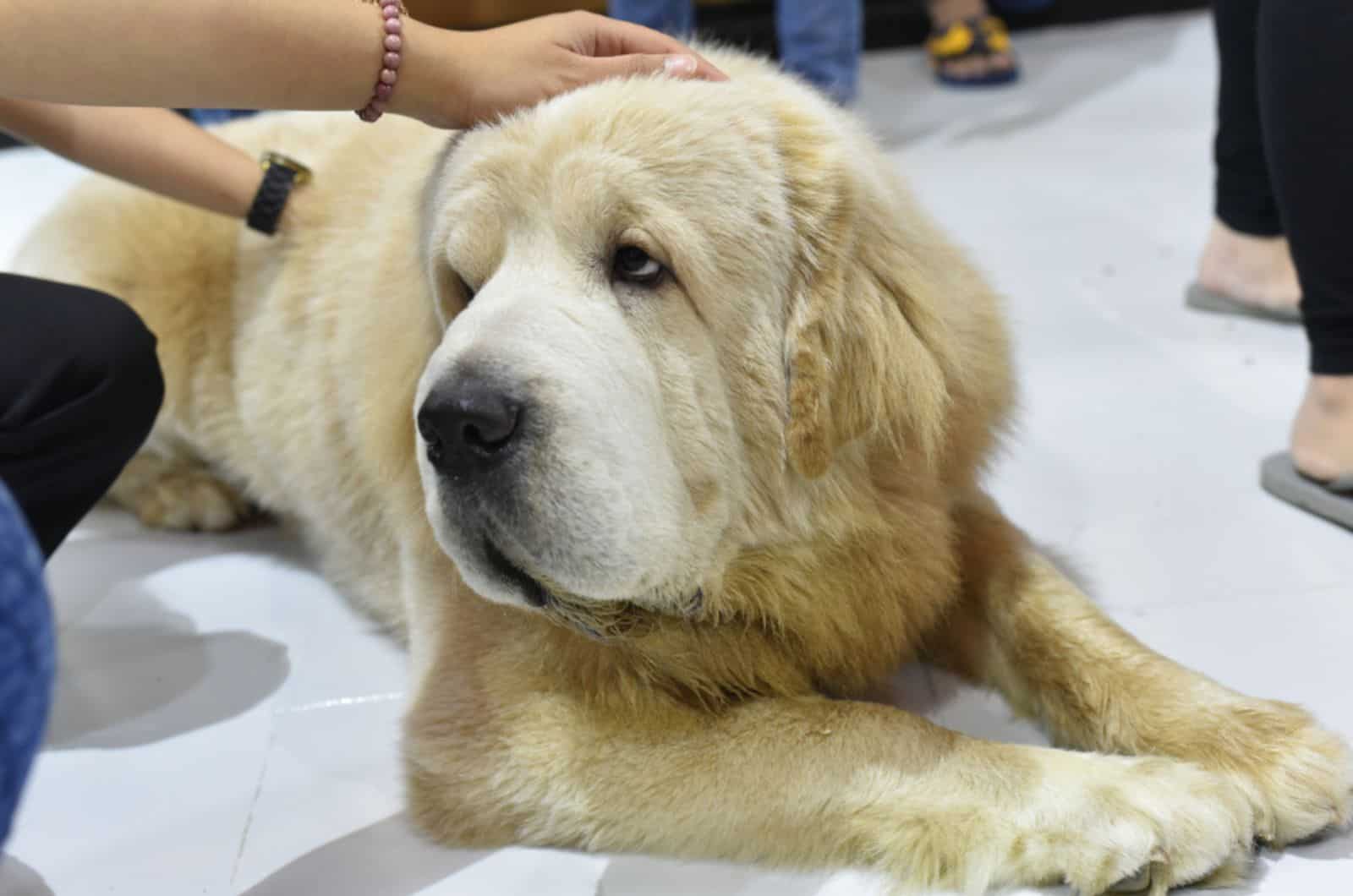
Clearly, there is a variety of colors when it comes to breed-standard options, but what kind of color listicle would this be without some “illegally” rare coat colors?
One of the Tibetan Mastiff breed traits is its wide spectrum of coloring mixes. Basically, you can have a solid-colored, two-tone, and three-tone Tibetan Mastiff. Like that was not enough, there is a sable pattern, too.
1. White Tibetan Mastiff
Canine genetics, and genetics in general, say that white is an absence of color. For this reason, the white Tibetan Mastiff is incredibly rare. This pigment mutation is not common in the dog breed.
A lack of melanin or levels that are too low causes a white coat in dogs. However, the story is more complicated due to the many unknowns surrounding the MITF gene that controls the distribution and development of melanocytes (melanin cells).
This MITF gene is located on the S locus, which can produce white spotting or a completely white coat color in dogs. For an expression of a full white coat, both parents have to pass on the recessive gene (S/S) to the puppy.
Still, having two copies of this allele does not guarantee a fully white coat. Geneticists are yet to discover other possible reasons for a full white coat other than a recessive gene pair on the S locus.
Interestingly, most fully white-coated dogs with a double S allele express a lighter eye and nose color, which is not the case in white Tibetan Mastiffs. Their nose remains black, and their eyes are dark brown.
2. Chocolate Brown Tibetan Mastiff
We already established that a pair of recessive genes on the B locus creates a brown coat color. Since the dilution of the black color by two b alleles on the B locus gives a brown shade, the chocolate color is a type of black diluted into brown, right?
Well, the process here is somewhat more complicated. Certain loci interact with each other to create the final coat color. The B locus has a close relationship with the A, K, and E loci, which can modify the shade of brown.
For a chocolate brown, it is the E locus with a pair of recessive genes and two dominant genes on the K locus that work to create this particular type of brown. If you want to visualize the color, think chocolate Labrador retriever.
3. Cream Tibetan Mastiff
This particular color is a strong dilute of the phaeomelanin or red pigment. By now, you probably know that the E locus with two recessive genes (e/e) stops eumelanin production, so the only possible color is red.
A cream color is achieved when the e/e pairing interacts with the A, K, and B loci for more pigment information. Two recessive genes from the K locus (dominant black) and B locus (dominant black) will further dilute the red into a cream color.
Sometimes, the dilution is so strong that looking at a cream Tibetan Mastiff from a certain angle in daylight will make it appear white. The cream color also further mellows its imposing stature, so this shade can deceive an observer into thinking it is a giant softie.
4. Cream Sable Tibetan Mastiff
The process of getting to the cream main coat color is the same as with the cream-only coat, but this time the interaction of the E locus with the A locus produces a sable pattern.
I already explained that the Aʸ is the dominant gene, followed by the aʷ allele, which is dominant recessive. Either one will create fawn or sable patterns paired with other recessive genes, but in Tibetan Mastiffs, the fawn variant is usually not expressed.
Tibetan Mastiff FAQ
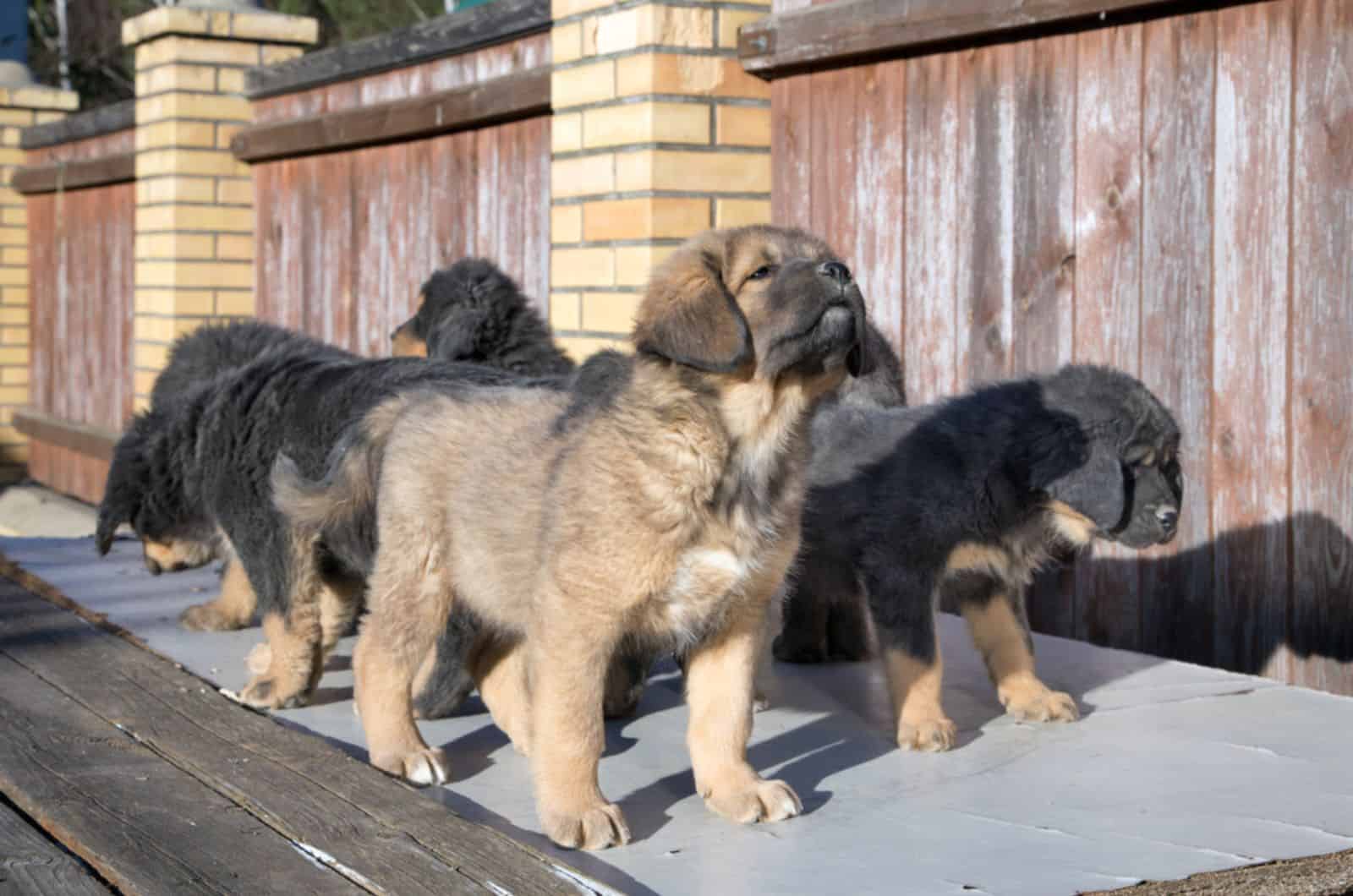
Although not officially recognized by the AKC or other kennel clubs in the US, there are two variants based on the coat length in particular spots on the head and body and muzzle and skull proportion.
The tiger Tibetan Mastiff, also known as the Tiger Head Tibetan Mastiff, has no mane on the neck and visibly shorter hair on the ears and head. The lion Tibetan Mastiff or Lion Head has a rich mane with hairs on the head and ears that is two or more inches long.
With a slightly larger skull and shorter muzzle, the Tiger Head has a more robust appearance than the Lion Head. In terms of other physical features, both are identical. A thing of note is that Tiger Heads are most commonly seen with a full black, brown, or reddish coat.
Breed purity is always associated with a breed standard. The kennel clubs around the world agree on most physical features except a few coat color combinations that some Asian kennel clubs consider standard and their US counterparts do not.
There are many physical and temperamental traits that make the Tibetan Mastiff purebred, so let me quickly list them for you.
Being a dog of large size, male Tibetan Mastiffs can weigh between ninety and one hundred fifty pounds, while females are slightly lighter at seventy to one hundred twenty pounds.
Since they can grow incredibly tall, the breed standard recognizes a minimum of twenty-six inches for males and twenty-four for bitches. The body frame is longer than its height, with thick bones and dense musculature. See our Tibetan Mastiff growth chart for more information.
Brow bones are pronounced and are almost perpendicular to the stop, which connects to a muzzle of medium length and square shape at an angle slightly higher than ninety degrees. The skull is wide and massive with a flat back.
The Tibetan Mastiff must have slightly slanted, deeply set eyes of brown color (shade not important). Ears shaped like the letter V should be moderately big without large gaps between them and the skull. They should also tilt forward.
A neck that is muscular and arched should be moderately long to match the rest of the body. A thick mane is a breed trait that should be fully developed in adult males. The chest is broad and reaches under the elbows.
There should be a visible but not eye-piercing tuck at the inside of the hips without creating disproportion with the strong musculature of the back. A straight back continues into a medium or long tail that should be abundant in feathering and curled over the back.
Both shoulders and hindquarters are muscular and perpendicularly set to the thick leg bones. Dewclaws can be removed or left, but one on the front and one or two on the back feet are standard.
A medium-length double coat makes them appear even larger than they are, in addition to providing weather resistance and warmth during cold winters. Male Tibetan Mastiffs have more coat overall due to the mane and heavy feathering.
Due to a dense, almost woolly undercoat, and tough hair, grooming will be a serious chore. Heavy shedding, especially during seasonal coat change, means that people with allergies should not consider the Tibetan Mastiff as a house pet.
Belonging to the large guardian dog group, these giant, ancient canines from Tibet are exceptional guard dogs. A high protective instinct does not exclude their affection towards the family.
Though loving, their character follows that of similar independent, individualistic dog breeds. The Tibetan Mastiff enjoys time alone, so it is not the best choice for families with young children.
Moderate energy levels and playfulness paired with average trainability make for a head-strong dog. They are work-driven dogs that enjoy large open spaces. Apartment life is definitely not recommended for such a large breed of territorial dog.
A large chest will produce some loud barks, and to be honest, they are easily triggered by other animals and strangers. A pair of earplugs is highly advisable.
Early socializationis incredibly important if you have other dogs or animals as pets. They are a mountain of a dog with high levels of confidence, and having other animals might entice them to show dominance and aggression too often.
They will enjoy long walks but guarding and herding are two activities that provide the most mental and physical stimulation. Leaving them alone at home might end in some interior damage, so be mindful of how much time your Tibetan Mastiff has spent by itself.
Considering the scarcity of breeders and the dog breed in general, if you are looking to purchase a Tibetan Mastiff in the US, you are looking at $1700 to over $7000 in acquisition cost alone.
If you are looking at some of the rarer Tibetan Mastiff Colors, you could quickly end up in the tens of thousands of dollars, so it is good to be conservative sometimes.
If you take into consideration how much the dog eats and the space requirements, alongside many other factors, the actual cost is much higher. Here is an in-depth breakdown of how much buying and maintaining a healthy Tibetan Mastiff will cost you.
Breeding Tibetan Mastiffs in the US is tricky due to the relatively low number of pure bloodlines that put the dog at risk of some genetic diseases establishing themselves firmly into the lineage.
For this reason, breeder choice is the first thing to research well before pulling the trigger on purchasing a puppy. Only consider breeders who have the whole panel of DNA tests done on their adult dogs, and practice ethical breeding (no inbreeding or crossbreeding).
Still, it is impossible to guarantee a dog will not develop some condition. This is particularly important for diseases that the Tibetan Mastiff is predisposed to. Let us have a look at those.
Lowered production of the thyroid gland hormones (thyroxine and triiodothyronine) is called hypothyroidism. This gland is crucial for normal metabolism, body temperature control, and nutrient absorption, so it can be devastating for such a large dog.
With Tibetan Mastiffs, the most common type of condition is autoimmune lymphocytic hypothyroidism. It differs from thyroid gland atrophy in that the immune system itself attacks the gland trying to neutralize the (ill)perceived threat.
Symptoms include lethargy, poor coat, bald patches, weight gain, increased blood cholesterol, and a slow heart rate. Secondary conditions can develop with hypothyroidism — keratoconjunctivitis sicca, infertility, skin thickening, or nerve damage.
Without a cure for this condition, the only treatment is synthetic hormones. A proven and most frequently used replacement hormone is levothyroxine, which has to be given to the dog for the rest of its life.
This condition is commonly present in many dog breeds. Larger dogs, such as the Tibetan Mastiff, can experience a faster development of symptoms that results in more damage done to the bone tissue.
Dysplasia develops while the puppy is still growing and is described as an underdeveloped ball that does not properly fit into the elbow or hip socket. This anatomical abnormality will create an odd fit between two bones of the joint, causing the cartilage to deteriorate.
Without a proper cushion, the cartilaginous tissue will completely wear off, and two bones will start grinding against each other. The damage to the bone tissue will ultimately cause arthritis and serious pain to your dog.
Tibetan Mastiff puppies grow more slowly than other dog breeds, so the onset of symptoms might be delayed by months or even years. You might notice limping, difficulty lying down or sitting, unnatural gait, pain while moving, etc.
Standard treatment includes NSAIDs for the pain and surgery once the bone tissue is damaged to the point that the hip or elbow anatomy is severely compromised. A surgical procedure called femoral head ostectomy is performed on dogs that have moderate movement impairment.
For more severe cases, full hip replacement is the only option that results in a good quality of life. This can be further improved by lifestyle and diet changes, alongside adequate secondary care.
Though it is a congenital disease, the cause for it is still unknown. The membranes that are present in the eye before birth are actually remnants of capillaries that provide nutrients necessary for lens development.
In Tibetan Mastiffs, these membranes can remain in the eye even after four or five weeks of age when they are supposed to be completely gone. Despite it being essentially harmless, these formations can cause problems with vision.
These string-like structures can start becoming less visible as a Tibetan Mastiff puppy gets older. Even if they do not fully disappear, it is less likely the dog’s vision will be affected.
Suppose no serious symptoms develop as a result of PPM. In that case, hyperosmotic drops are usually prescribed to reduce any potential swelling, but surgery is the best option for dogs with cataracts that may appear because of PPM.
Among all of the inherited diseases, hypertrophic neuropathy has been exclusively associated with Tibetan Mastiffs.
The condition is defined as a degenerative disease that causes “severe reduction in nerve conduction velocities, infrequent denervation potential, and inconstant elevation in CSF protein”.
It affects puppies in litters that have been weaning for a few weeks, with symptoms that include general weakness, muscle hypotonia, and hyporeflexia.
A type of cell called Schwann cell showed signs of aberrant formations in the insulation layer that it forms around the axon of a neuron, which indicated another element had to be present for myelin degradation.
There is no known treatment, but research on peripheral nerve grafts has shown that there was more to CIHN than Schwann cell defects.
For a large dog breed, Tibetan Mastiffs have a pretty good health record and can live between twelve and fifteen years. A comprehensive diet and lifestyle that aims to maintain physical and mental needs satisfied should get you closer to the upper age limit.
Conclusion
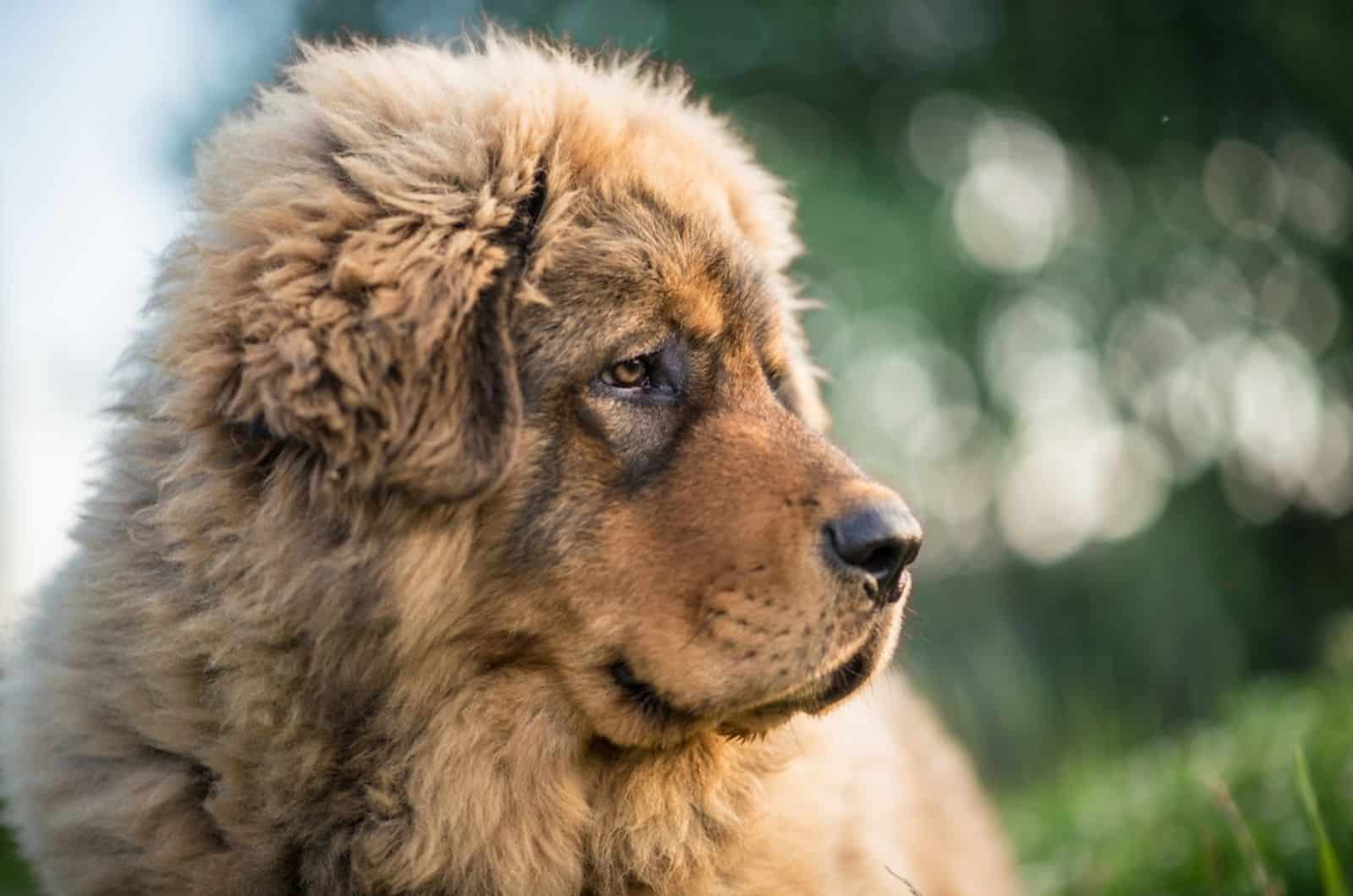
With such a rich palette of Tibetan Mastiff colors, you should be more than content with the possibilities. Choosing the right shade is completely on you, and we even made it easier to find a breeder with this list of the best Tibetan Mastiff breeders in the US.
If cost is not a concern, I recommend going with the blue-gray and tan option as it is both standard and not so common. Rest assured, you will not see many people walking their Tibetan Mastiffs around.
As this is not a dog breed suitable for apartment life or first-time dog owners, I advise you to go for a Rottweiler if you want excellent protective instincts without the gigantic size and aloof character.
Finally, consider adopting a rescue from this rescue center dedicated to Tibetan Mastiffs. There is a price for these dogs too, but much lower than what you would pay for a purebred TM from a breeder, and you would be saving a dog someone abandoned due to ignorance.
